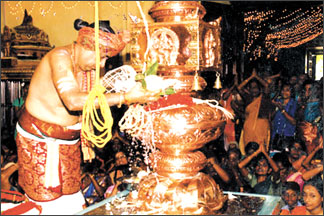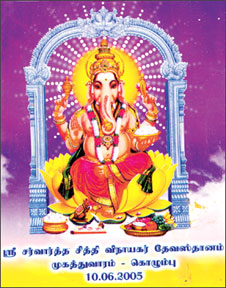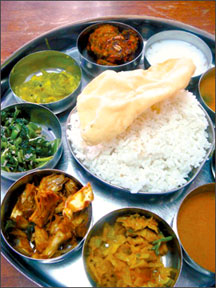|
Hinduism
‘Ganesha Chaturthi’ at Sri Sarwartha Sidhi Vinayagar Temple, Modera
Kalabhooshanam Chelvatamby Maniccavasagar
The Beauty of Lord Ganesha worship is extra-ordinary in that it is
not confined to any particular country or sect alone. Forms of his
worship prevailed in the Far East and in the Far West from Japan, China,
Mongolia and Peru and also for flung Isles of the Indian and Pacific
Oceans in the South. In fact, Ganesha is the Lord of beginning, the very
embodiment of the material universe. He is worshipped with deep
affection by Hindus.
 The observance of “Ganesha Chaturthi” burns up all our karma. In
whatever form or worship we invoke him, in whatever languages we sing
his praises in His Holy abodes, all reach the lines Guru Ganesha, the
principle of knowledge, the self of all which lights up everything. The observance of “Ganesha Chaturthi” burns up all our karma. In
whatever form or worship we invoke him, in whatever languages we sing
his praises in His Holy abodes, all reach the lines Guru Ganesha, the
principle of knowledge, the self of all which lights up everything.
Lord Ganesha’s worship is most effective in illuminating
consciousness and hence he is sought after and propitiated by the Hindus
as well as by the Vaishnavites, Jairs and Buddhists as the dispeller of
obstacles.
The saintes who follow the Sarya and Kriya paths worship Lord Ganesha
with meticulous rites and rules of conduct.
Further, observing ceremonial fasts and festivals centuring round
temples made famous in the religious scriptures. Fasting on “Chaturthi
Day and offering red flowers to his image have been practised by
devotees in order to restrain Lord Ganesha from imposing hindrances and
also to steer their undertakings to success.
In fact, the observance of “Ganesha Chaturthi” is meant to remove the
veil of attachment that covers our hearts and also to get rid of any
obstacles in life and work towards achieving one’s goal.
Indeed “Ganesha Chaturthi” and the annual festival of Sri Sarwartha
Sidhi Vinayagar Temple at Modera, Colombo 15 were held recently under
the chief trustee of the temple Dr. A. S. Kunasingham father.
All the religious rituals during the Ganesha Chaturthi and annual
festival were performed by the chief priest of this temple “Sivagama
Kiriya Yothi” Shiva Shri K. Somasundara Kurugal with the assistance of
several other Archchariyas.
Every Hindu temple has a sanctum dedicated to Lord Ganesha. Hindus
bow their heads in reverence and make this first offering to Lord
Ganesha in all ritualistic worship. Be it pilgrimage, wedding, Yaga or
housewarming Lord Ganesha is the first deity to be worshipped at the
beginning of any ceremony.
Vinayaka, Ganapathy, Vigneswara and Pillaiyar are some of the common
appellations given to Lord Ganesha. The bulky body of Lord Ganesha
stands for the cosmos in its entirety. The huge pot-belly signifies
space containing all things and beings of the world. The trunk
represents the sensitive reception of cognition. It also signifies the
faculty of discrimination.
The broken tusk signifies that he has broken away from ignorance
which guides the path of God. The single task also denotes single
mindedness in action. The other tusk indicates knowledge.
The Lord of attachment in his hand is the invisible link of unity,
binding the multiplicity of things in one hand, he holds a hatches (Parasu),
a symbol for the cutting away of vanity. In another hand he holds a goad
(Ankusha) symbolising the logic that cuts through illusion in another a
noose (pasa) representing the restraint to passion and desires.
 The spear like weapon also indicates that he uses it to destroy
ignorance in his devotees. The third hand of his holds a dish of Modakam. The spear like weapon also indicates that he uses it to destroy
ignorance in his devotees. The third hand of his holds a dish of Modakam.
This signifies that he distributes the consequences according to the
action of the Jeevas. The Modakam also symbolises the fullness of
Brahman. The fourth hand of Lord Ganesha represents Abhaya.
Rat is Lord Ganesha’s vehicle. This shows all beings high and low,
big and small are the vehicle to the divinity enshrined in the hearts.
The rat also stands for time. God is beyond time. The mouse is the
appropriate symbol of time.
A common form of worship of Lord Ganesha is rapping at the forehead
with knuckles and pulling earlobes with crossed hands. This act helps in
the purification to Naadis.
Smashing coconut shows that the hard nut of ego should be cracked and
get rid of before God and subsequently prostracted for complete
surrender.
Further the camphor that is burnt in front of Lord Ganesha significe
that we have to burn our illusion of ego with the fire of true knowledge
and leave no residue so that we may merge with God.
Undoubtedly, those who worship Lord Ganesha and observe with
meticulous care “Ganesha Chaturthi” will be removed of all their
obstacles that stand in their way to attain plentitude and success.
Understanding Hinduism IV:
Omnipresence of the Almighty
K. S. Sivakumaran
Readers please note that what I write in these columns may not be
orthodox Hindu point of view. I am only expressing my thinking and
understanding of this great religion as I understood it. Readers would
have also noticed that my interpretation is shaped within my limitations
of my intellect. Where did I gather the knowledge of the Hindu religion?
Well, I am still learning both the Saiva Siddantham and the Vedanta
as aborn Hindu. But what I have stored in my little brain is what my
dear father, the late Kailayar Sellanainar, taught me.
He was an ardent reader of both the western and eastern philosophies.
He used to read Bertrand Russell, Sarvapalli Radhakrishnan, Huxley and
others like Brownski of his generation and also Thaayumaanavar and other
Thamilian saints.
Although he and I are born as Thamilian Saiva Siddhantists, we would
like to describe ourselves as persons having a world view on many
matters, including religion. As far as Hinduism was concerned my father
had a bent towards Vedanta.
 |
|
A group of tourists visited Sri Siva
Sibramaniga Swamy Kovil in Slave Island. The members of the
Kovil Trustee explained them the importance of the temple.
Picture by Kotagala group corr. |
In addition, I learnt the quintessence of all great religions by
reading western authors particularly reading Colin Wilson’s The Outsider
and Beyond Outsider and also researched pieces in Thamil on Saiva
Siddantham. I also read Lankan Thamil writer the late M. Thalayasingam’s
Meiyul.
Let’s get back to the subject. Let’s see what is termed as God or
Almighty.
The Materialists think that the humans evolved from matter and the
spiritualists think that they came from God. Both look through the same
telescope but from opposite ends. We all know that both Science and
religion are in the realm of speculation starting from opposite poles
and their progress in the final analysis might well end in the discovery
of a circle.
To the humans the whole universal is only a reflection of God who
animates everything everywhere. In Thamil they say “Avanantri oar Anuvum
Asaiyathu”.This means not an Atom could move without Him. The truth is
that God is not outside us. He is within us and around us. We live and
move with him. He can never be detected or discovered by any instrument
of the Scientist nor can he be made the object of his researches as He
is eternal.
He can never be made the object of research or study.
God is everywhere. The Vedic sages discovered this and subsequent
generations never questioned the validity of that statement. It is being
repeated by everyone even now.
That God is everywhere will be repeated eternally. Science throws no
light on the nature of the spirit of Human or God. I do not know whether
the Scientists have located even the mind within our small human bodies.
Then how can we expect the scientists to locate God?
A Scientist cannot control the mind. With the help of drugs and
instruments he might be able to modify the mind but he cannot make it
think as he wants. History reveals that dictators and mind benders have
failed in controlling the minds.
I have no personal experience of having seen God anywhere much less
everywhere.
All I can truthfully say is that I see a variety of things
representing God. My personal experience is that in Shri Sathya Sai
Baba, I see a representation in embodiment of the attributes of God.
This again is my felt experience.
The five senses bring in a good deal of information from outside and
by using our intelligence we are able to conceive certain ideas. Beyond
that our mind cannot extend to other realms. It is also within the
experience of all of us that at times we get flashes of intuition if we
can concentrate sufficiently long on any subject.
We may therefore assume that the Sages saw God everywhere in such
moments of insights. But the thing is that most of us are spiritually
blind and therefore cannot see Him everywhere. It could be She too.
Irrespective of their race or country of birth, all sages felt or saw
God.
How is it that we do not see God when the Sages are able to see is a
pertinent question?
Let’s try to give an example as an answer to the question.
Take the different pieces of furniture in a room. They are all made
of teak wood. They are made of timber is the fact, but we label the
pieces with different names. If we call the carpenter to repair any of
the pieces he does not see the pieces as he looks only for the kind of
timber by which they were made of.
When we look at different pieces of furniture we look at their form
or design and never look at the substance. But the carpenter looks for
the substance. That’s the difference.
The form and names can be maintained only in space and time which
have no real existence except in relation to some substance or event.
The substance is the real and it does not change in any way.
A picture predominantly red in colour would be viewed differently by
an artist and say a buffalo, while the artist sees a beautiful sun set
in the picture, the buffalo will see only the red colour and would
charge against the picture.
God is the substance and the humans are manifestations of Him and HE
resides within us and everywhere.
Vegetarianism - Hindu perception
Dr. Vimala Krishnapillai
All religions are in quest for spirituality but their perceptions
vary on vegetarianism. Hinduism also known as Sanathana Dharma or
Vaidika Dharama is based on the bed rock of Ahimsa and jivkakarunia, non
violence and compassion . Vegetarianism is fundamental to uphold ahimsa
or non violence.
As respecting all forms of life being integral to this, Hinduism
advocates a vegetarian diet. Vedic and agamic scriptures proclaim
“Injure not the beings living on earth, in the air and in water.”- Yajur
Veda. The Hindu sages and saints have clearly laid down restrictions on
diet and conduct the scriptures speak clearly and forcibly on
vegetarianism.
The brotherhood of life belongs to birds as well as beasts say the
sages. Accepting the sanctity of all life both human and animal they
advocate vegetarianism which encompasses abstinence from eating meat,
fish and eggs. Two of the other religions Buddhism and Jainism which
originated in India too endorse it.
Hindu scriptures, embracing in its fold a broad spectrum of
philosophies and belief systems have voiced their thoughts and feelings
on this subject of vegetarianism over and over again.
 But not all of the one billion Hindus abstain from killing or eating
flesh. Even animal sacrifices, a primitive and crude practice, though
rare, are still prevalent and are done in the garb of religion. Saivism
and other refined Hindu denominations have prohibited this practice. But not all of the one billion Hindus abstain from killing or eating
flesh. Even animal sacrifices, a primitive and crude practice, though
rare, are still prevalent and are done in the garb of religion. Saivism
and other refined Hindu denominations have prohibited this practice.
Among the primary denomination of Hinduism, Saiva Agamic tradition of
Saivism, indigenous to Tamil Nadu and Sri Lanka stresses Ahimsa as the
greatest dharma and as such it is obligatory for a Saivite to be a
vegetarian.
As a corollary of this, the Tamil word ‘saivam’ in common parlance
connotes vegetarianism and ‘asaivam’ non vegetarianism. Today there are
a vast number of Saivites who had guiltily abounded vegetarian ways of
their parents and grandparents when they decided to be secular and
modern.
But it is a paradox that many of the Saivites uphold vegetarianism
only on special days of religious significance. However a few Hindus at
some point in their life once and forever turn up completely vegetarian
in fulfillment of vows or after pilgrimages especially so to most sacred
places such as Kashi. Others do it step by step give up red meat first
followed by poultry and eggs.
No where else is the principle of non-meat eating fully expressed so
eloquently as in the sacred Thirukural. The ancient and timeless Kural,
which is well over two thousand years old, has been venerated by the
Tamils as their ethical code of percepts for a perfect life. Krural is
relevant today as it was then. The sage poet, Thiruvalluvar lays down in
his Kural:
‘All life will raise their hand in worshipful adoration.
To those who refuse to slaughter or savor flesh.’ - (260) Thirukural
“How can he practice true compassion when he eats the flesh of an
animal to fatten his own flesh”(251)- Thirukural
“If the world did not purchase and consume meat no one would
slaughter or offer meat for sale.”(256 )- Thirukural
The act of the butcher starts with the desire of the consumer ‘There
are three forms of killing: He who kills the animal, sells the meat, the
purchaser of the meat, the one who eats it, even those who cook it and
serve - all these are to be considered as meat - eaters’ says -
(Anu115.47) Mahabaratha
The Bhagavad Gita explains how ones psyche, personality, mood, mind
and bodily tendencies are shaped by the food one eats. Flesh and pungent
food is said to promote Tamas a temperament that is full of inertia,
stupor, callousness inducing a person to be aggressive and agitated.
This contributes to the mentality of violence.
Fruits, vegetable and milk promote a satvic calm tranquil mind which
is conducive to spiritual progress. Research studies in the jails of
India have proved that vegetarian diet change criminal behaviour for the
better. “When the diet is pure the heart and mind are pure.” - (257)
Manu Samhita
Food is the source of our body chemistry what we take in affects, our
consciousness and emotions. Medically too there is sufficient research
evidence now to support that diet influences a person’s behaviour due to
their action on the neurotransmitters. And that vegetarian food brings
about tranquility, concentration and also makes the body healthy and
strong.
It is heartening to note that in the last decade or so, the western
countries are turning towards vegetarianism in large numbers for good
reasons other than religion. George Bernard Shaw (1856 - 1950) the great
dramatist and critic asks ‘While we ourselves are the graves of murdered
beasts how can we expect ideal conditions on the earth’.
All beings are terrified of cruelty, pain, and fear of death and are
also capable of displaying higher emotions. The response and the
sensitivity of the animal nervous systems to the above emotions increase
with their higher placement in the scale of evolution.
How is it possible to swallow the carcases of slain creatures,
permeated with the violent energy of pain and terror locked up in them
during butchering? Harmful hormones and toxic chemicals released in the
animal during the fear terror and pain experienced during killing along
with the disease causing micro organisms are ingested by the meat-eater.
Converting to vegetarianism is not too difficult. It may be done all
at once or gradually. Among them many who have fully adapted vegetarian
diet, after for about one year or so about, say that even the very
thought of eating flesh is nauseating to them.
Pleasure relates to the body and bliss to the soul. Vegetarianism is
food both for the body and soul. |

